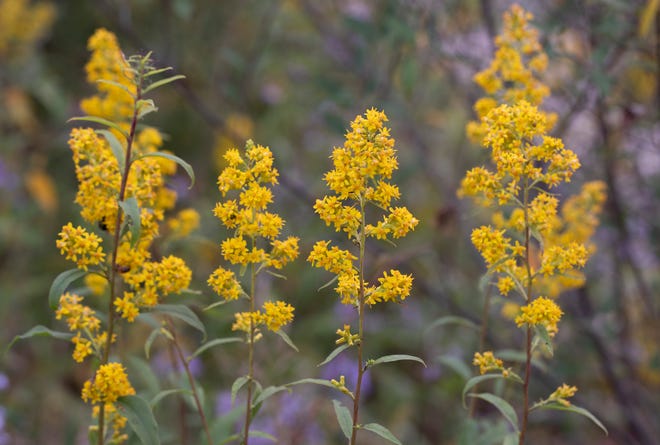Native plant update: Of Ohio's 1,800 native plants species, 271 are endangered, 93 are gone

Ohio is a crossroads state when it comes to natural history. A convergence of major habitat types comes together in our region, spawning a great diversity of flora, which in turn means a vast array of fauna. Midwestern prairies reach their eastern terminus here. While scattered relicts occur further east, about 5% of Ohio was prairie at the time of European settlement. Indiana was 15% prairie, Illinois about 60%, and Iowa 80%. The formerly great Midwestern prairies have largely been eradicated, with less than a percent remaining.
Boreal forests and bogs dipped into Ohio from the north, offering a taste of Canada. The Appalachian Mountains reach their western limits here; 32 of the state’s 88 counties are considered part of Appalachia. Four hundred and fifty one miles of the mighty Ohio River form Ohio’s southern boundary. The valley of this great stream is the northernmost limits for a number of southern plants.
All of this ecological diversity means plants, and lots of them. About 1,800 native species have been documented in Ohio. Unfortunately, we’ve been very hard on habitat.
In 1800, Ohio’s human population was about 45,000. Today, it is approaching 12 million, an increase of 26,527%. This avalanche of humanity has wrought great changes in our natural resources. Of Ohio’s 1,430,000 acres of pre-settlement prairie, less than one-tenth of a percent remain. Ninety-two percent of our bogs and other peatlands have been destroyed. While 95% forested at the time of settlement, Ohio’s forest cover has dipped to as low as 10%, and is about 33% today. Forestry practices and fragmentation have greatly diminished the ecological value of many remaining forested tracts.
A catfish with a bite:Nature: Venomous madtom catfish a lesser known species in Ohio that packs a punch
A great many of those 1,800 native plant species have taken it on the chin due to the hand of man. Nearly 650 species are now listed as being in some degree of imperilment by the Ohio Department of Natural Resources’ Division of Natural Areas and Preserves (DNAP). DNAP is the state’s authority on Ohio’s flora and maintains the biennially updated Rare Native Ohio Plants Status List. The most recent iteration lists 271 endangered, 159 threatened, and 92 potentially threatened species. A further 93 species are considered extirpated — gone from the state.
Sometimes plants are thought to be rare because of their obscurity factor. They are difficult-to-identify species such as grasses and sedges, known by few people, and their true status can be tough to quantify. Over time, however, botanists are usually able to accurately determine their status and many such plants have had their status downgraded or been removed from the list altogether. Other species are at the edges of their ranges in Ohio, and may only occur in a county or two, although they are common elsewhere. Some plants are genuinely rare, such as the five federally threatened species found in Ohio.
The gorilla in the room is habitat destruction, though. In 1837, a displaced Vermonter living in Illinois, John Deere, launched his steel chisel plow. It didn’t take long for the vast Midwestern prairies — some of America’s richest biodiversity — to become America’s breadbasket. Scores of prairie specialist plants were replaced with a botanical triumvirate of beans, corn and wheat.
Captivating spider:A spider that can catch fish? It's true. Find out more about the species in Ohio
Cities and suburban sprawl have displaced forests and meadows, and poor treatment of Ohio’s 60,000 miles of streams and numerous natural lakes have led to greatly diminished water quality. One group of aquatic plants, pondweeds in the genus Potamogeton, have been especially hard-hit. Of the 23 species, six are endangered, one is threatened, two are potentially threatened, and five are no longer known to occur in Ohio.
Twelve species are listed as imperiled in Franklin County. Two are endangered and one of those is a beautiful little mustard known as spreading rock cress (Arabis patens). It is especially significant as it was discovered by botanist William Sullivant on rocky cliffs along the Scioto River in Dublin in 1842. Probably less than 100 plants survive. Sullivant’s father was Lucas Sullivant, founder of Franklinton.
Conservation and restoration of habitat is the most important thing that we can do to protect Ohio’s rich biodiversity. Only about 4% of Ohio is protected in the form of parks, wildlife areas, nature preserves, national forest and the like. The Department of Natural Resources, U.S. Forest Service, The Nature Conservancy, various county parks and other conservation organizations have done much to ensure the perpetuation of our botanical heritage. But much more remains to be done if we are to arrest the decline in Ohio’s flora, and ideally, increase our botanical diversity.
Naturalist Jim McCormac writes a column for The Dispatch on the first, third and fifth Sundays of the month. He also writes about nature atwww.jimmccormac.blogspot.com.